It’s a pleasure to dismount a very well-engineered product, both from usability, from technical and production aspects.
|
Disclaimer: innovation.world has no financial incentive whatsoever, nor any ownership in the product reviewed. Products are chosen based on the only factor of having interesting or original designs to share with other industries. These products are on the market for years; Innovation.world has not and does not disclose any special or confidential information, but only what is visible by dismounting, observation and knowledge from similar technologies. Note however that these designs may be patented by their respective owners. |
The product is an automatic garden water dispenser, a so-called water timer, intended to be mounted vertically on the water valve, before the hose watering the garden.
Some more expensive and many cheaper products exist. We choose to review this one for its visibly great design and manufacturing quality & ideas.
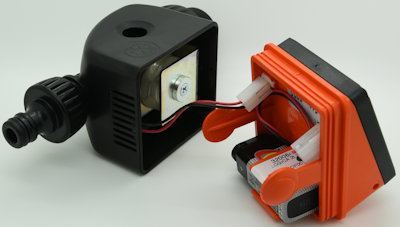
Dismounting & Design Review

The main cover holds by two cavities in the main orange housing part. A simpler mold design could have taken place, but at the cost of a nicer aesthetic. That could have probably been acceptable if the two parts were of the same color.
Note that the right sketch would require thicker walls at the end of the two protrusions and not a blade-thin shape.
Opening clips
Achieved from shapes in plastic & used to place or replace the 9V battery
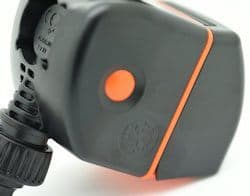

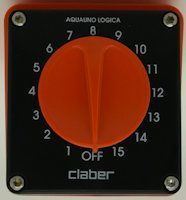
They have a round shape + orange color in the middle of the black case, making them instantaneously accessible and visible.
TIP: the ribs on the back of the clips are a great way to still have some possibilities of adjusting the stiffness of the clips. You start with relatively small ribs and increase their size progressively in the mold (providing you thought in advance not to put cooling channels too close in that area)
The main body incorporates two groves. Wider, only one would have been needed to fit an o-ring for a perfect seal (but maybe not aging well too much). These two groves permit at least some reasonable IPXX protection for this application, but we would not be surprised if a corroded battery would be the first (only?) mode of failure of this product.
On the opposite, the main selector is not end-user dismountable and has therefore not-so-common 4 star-shaped screws.
Inside connectors
One is connecting the electro valve and the other the battery.
As they are located in the not waterproof chamber (see below about the openings), they have some sealing protecting the electronic chamber. It is obtained (probably the bit-painful operation of all the process … time for curing/drying and something traces droplets on inner the plastics

They are designed and located very smartly, making a “natural” poka-yoke:
They can not be inverted, due to a different distance between the pins
Moreover, one connector can not be turned 180° and connected, although the pins are symmetric. This is simply achieved by putting the pins very close to the housing; the 2mm remaining gap can only fit one side on the connector, making the 180° inversion impossible during production or end-user “playing” with it as this cavity is very easily accessible in order to change the battery.
Openings

They are located on the bottom, to let any water escape (This product is intended to be screwed on the outlet of a garden valve).
This is an important design choice: either perfectly sealed -very difficult to achieve in such application- or must be very open to letting any accumulated water flow or evaporate easily before causing damage or corrosion.
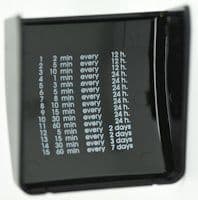
From our experience, openings seem to be quite numerous for the venting purpose above, but small enough to prevent wasps from building inside (not verified); small ants or similar size could probably enter but is less of an issue.
Basic settings are printed inside the cover to avoid using the IFU; protected from scratch, and visible when open to turn the knob. Simple & efficient!
Note: although they are very simple to understand, they are in English! some countries may require the local language
Back & labels

All the back has been hollowed to maintain a constant thickness of plastics, although some ribs were made to maintain perfect rigidity
Life-cycle & usage analyse during specifications phase: user may not notice the constraints on the product while pulling the garden hose 20m away
“9V” is simply molded and is enough to be specific to the battery size; the location of that printing could have been more on the case; that could have compromised the aesthetic a bit, but would be more visible.
Also, that could have been indicated on the case very clearly also, as this battery is not the most frequent in this type of garden application, compared to AA & AAA sizes.
Inlet filter
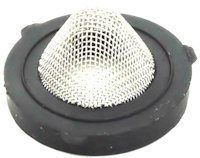
Overmoulded stainless steel meshes so that the sealing and filter are only one part.
the conical shape is obtained by the deformation of a flat mesh, probably by one side of the mold, while closing.

The elastomer is relatively thick for a seal, in order to over-mold completely the metal ends, but the thin circular lips on each side permit a front sealing without requiring a big effort to compress the complete surface.
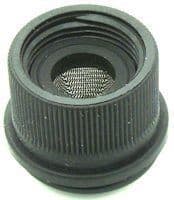
Note the 3 elastomer triangles: likely to maintain the filter in the female thread; the classical solution would have been to have an outer diameter bigger, but that would have made the filter bigger to insert or remove and can deform the front seal
Good usage of volume
A very compact in total compared to the content; it is mainly achieved by the battery locating well on one side while the electro-valve takes the other part of the square housing.
Internal Componentry details
In high-resolution pictures
Valve mechanism
A very nice example of a pilot valve aimed to reduce the opening/closing efforts required for magnetism.
The usual principle of a pilot valve: the ratio of surfaces produces pressure around the main valve membrane, thus maintaining the valve closed. By opening a small hole -needing small forces-, some fluid passes on the other site of the membrane, thus changing the ratio of surfaces, and then opening the main valve completely.
Nice integration also of the magnet into the stainless steel moving core.
Selector and Electronics
Made in...
You have read 67% of the article. The rest is for our community. Already a member? Log in
(and also to protect our original content from scraping bots)
Innovation.world community
Login or Register (100% free)
View the rest of this article and all members-only content and tools.
Only real engineers, manufacturers, designers, marketers professionals.
No bot, no hater, no spammer.

























